#are thought of post-veil. and then da4 does this but it's still like. the same afterwards. ]
Explore tagged Tumblr posts
Text
Another thing that I felt should have been present in DA4 but wasn't is the question of elven identity in relation to the revelation that their oldest ancestors were once spirits.
If it was in the game I either missed it, or it was discussed too briefly for me to be satisfied with what we got. In the initial conversation, elf!Rook can question if they are a spirit and immediately be met with "you were conceived naturally" which sort of circumvents the point of discussion. It isn't about what Rook is, but their ancestors were.
The only banter I recall was one between Emmrich and Bellara where it felt more like two people who just had their fan theories confirmed rather than grappling with the history of her own ancestry. Then one between Davrin and Taash where Davrin insists he isn't a spirit (which he isn't) but nothing more.
I don't think all elves, upon learning the truth, would turn and look at spirits and think "are they my people, too?" but I think some would. I think some would feel horrified, some would wonder if they are demons because they have been taught that spirits are just demons waiting to happen, some would reject it entirely or choose not to think of it. I think there would be a thousand permutations of reactions upon learning the truth, and it would have been nice to get at least two. Davrin sort of falls into the "I'm not thinking about it" category, but Bellara clearly is and we seem to get no indication to what that is. She literally has a spirit trapped in an object in her room and it doesn't matter.
The revelation is treated as practical- we can't tell people the truth because people hate elves, and people hate spirits. The connection is sort of rationalised out of existence.
It is such a point of frustration when so much of Solas in DA:I is being forced to reckon with the opposite idea: that these physically birthed elves are, in some manner, his people and what it might mean if they are real. DA4 confirms theories we've had for ten years but then doesn't really reckon with them in any manner that is narratively satisfying to me.
#da4 critical#( ooc )#( solas meta )#[ more a ramble bc im not editing this for coherency. and also barely abt solas. but i only have one meta tag ]#[ i've often said that i feel like solas's struggle w/ thinking of physical people as people post-veil is a mirror for how spirits#are thought of post-veil. and then da4 does this but it's still like. the same afterwards. ]
49 notes
·
View notes
Note
If the Spirit!Solas theory happens to be true—and I’m confident it is—then it really gives you a new level of respect for how much restraint this guy has.
I’m talking specifically about his interactions with Dorian. The part where Dorian is trying to convince Solas that enslaving spirits is cool and neat and not wrong because ‘spirits aren’t people.’
Imagine having the strength of character to listen to someone tell you to your face that you are not a person and therefore undeserving of the most basic civil rights without immediately decking them in the face.
Solas puts up with tool much, man.
Oh yeah, definitely! 😂 (As much as I feel for Dorian just trying to find some common ground...) I guess that one line in Tevinter Nights does a great job of putting Solas' attitude on this matter in a nutshell.
[…] roared not in anger, but with quiet contempt. "From this moment, should you ever bind a spirit, then your life is mine."
Keep in mind, Solas has witnessed spirits suffering from the consequences of creating the Veil for at least a thousand years at this point, if only from the Fade. When he's saying "It hurts. It always does." to the Inquisitor after returning to Skyhold and Wisdom's death, he's referring to the countless times he had to watch his friends being drawn to the waking world, either forced, or to see them “wish to join the living”, only to be twisted, bound, corrupted, killed, you name it.
"How small the pain of one man seems when weighed against the endless depths of memory, of feeling, of existence. That ocean carries everyone. And those of us who learn to see its currents move through life with their fewer ripples."
Much like a lot of his banter with Sera taunting him about his grief for the past, at this point, Solas is so old and has witnessed so much history, so much pain, that Dorian's remarks couldn't possibly evoke any real anger from him. It's so insignificant compared to what he has seen. There's a reason why Weekes keeps emphasizing how friggin tired Solas truly is. This is after all the general perception of spirits in present Thedas, aside from a few cultures like the Avvar. He can't blame Dorian for Tevinter raising him to think of spirits as nothing more than "amorphous constructs", just like he can't blame the Dalish for the knowledge lost to time. Similarly to any other argument he has with the other companions, Solas' frustration/resentment is almost never aimed at them personally, but rather at the current state of the world that shaped their perspective. (As is also evident in how his banter always ends up with them eventually coming to terms and grow a mutual/respectful relationship. The only exception being a low approval Inquisitor and Iron Bull if he chose the Qun over the Chargers… In that case, the hostility was definitely personal. 😂)
(That being said, I'm SO hoping for any kind of serious emotional outbreak from Solas in DA4, since there's still like a thousand year old trauma that needs to be addressed. lol)
But yeah, I think, going by his actions in Tevinter Nights, Tevinter is definitely not ready for what's probably coming for them in DA4, now that Solas is actually able to change things. 👀 And isn't it interesting how he will now be facing the Imperium, which was essentially built on the ruins of the empire he brought down/the same slavery based system he once rebelled against, so history kinda repeats itself? lol
I think it's also very telling how Solas will immediately counter Dorian's comments on the treatment of spirits in Tevinter by directly comparing it to slavery.
Dorian: "There's no harm putting them to constructive use, and most mages back home treat them well." Solas: "And any that show any magical talent are freed, are they not?" Dorian: "What? Spirits don't have magical talent." Solas: "Oh, I'm sorry. I thought you were talking about your slaves."
But the beautiful irony in this, as I've talked about in this post, is how this draws a direct parallel to how Solas, in return, doesn't recognize the people of the waking world as real either, at least not until after the Inquisitor considers Wisdom a living being worth saving. This and his admission to the Inquisitor after he returns to Skyhold is imo the turning point in his character development. Imo, this is what leads him to say "Not at first. You showed me that I was wrong." in his high approval ending in Trespasser.
And this is also why I think that the theory of Solas intending to save the spirits first and foremost would make for such an interesting story actually.
The waking world doesn't view spirits as real people. Just like Solas can't accept the people of the waking world as real. So, what will happen if he tears down the Veil, and the Fade and the waking world become one again? The Inquisitor was potentially willing to save Wisdom despite it having already turned into a Pride demon. And in doing so, the Inquisitor unintentionally put up a mirror in front of Solas' face and basically went "If I can see them as real people worth saving, why can't you?".
And if the spirit origin theory is true, then it could make for a fascinating inner conflict. Solas, living in both the waking world and the Fade, having been a spirit and a corporeal person, is now facing the question of who "his people" actually are. Where does he belong? After all, his biggest fear remains to "die alone".
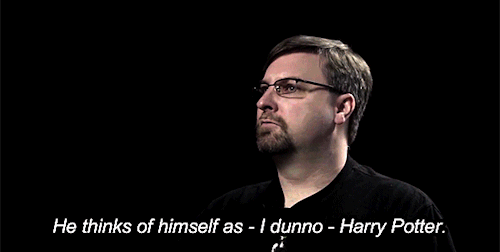
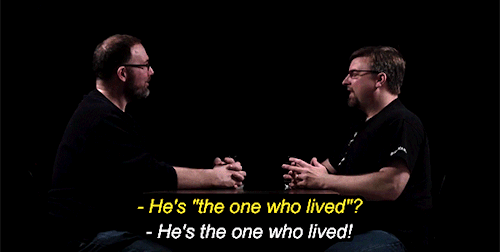
While this was said in more of a joking manner, Weekes' words from 2016 really put it into perspective here. Solas sees himself in that old fisherman he saw in the Fade. He is "the one who lived". So, I picture it like this… Solas is left alone in the Fade after the creation of the Veil. Spirits are now his only company for the next thousand years. Whether or not those spirits were the remaining souls of the elves he tried to save, we don't know, but regardless, I truly believe they are his people. But he is not a spirit. At least, not anymore.
Cole: "You don't need to envy me, Solas. You can find happiness in your own way." Solas: "I apologize for disturbing you, Cole. I am not a spirit and sometimes it hard to remember such simple truths." Cole: "They are not gone so long as you remember them." Solas: "I know." Cole: "But you could let them go." Solas: "I know that as well." Cole: "You didn't do it to be right. You did it to save them." Inquisitor: "Solas, what is Cole talking about?" Solas: "A mistake. One of many by a much younger elf who was certain he knew everything."
In this banter, Cole reveals to us that Solas' mind immediately goes from "It's hard for me to accept I'm not a spirit" to "the people that were lost when Solas created the Veil". To me, this pretty much confirms that the people of Elvhenan and spirits are connected, if not one and the same. It's assumed that the Evanuris mined the Titans to somehow create bodies for spirits to inhabit, and that Mythal gave Solas a body against his will. There's also the theory about the creation of the Veil having caused the separation of body and spirit.
You know, I've written so much about this in previous posts and I don't want to sound like a broken record, but if we consider all those little clues and look at all of his dialogue in that context, it just makes so much sense to me, that what he wants to do is primarily to save the spirits/destroy the barrier for them to enter the waking world without their purpose getting corrupted. There's also still the matter of the Blights and red lyrium otherwise probably consuming the entire world. 😅 I think that's what he's referring to when saying "What I am doing will save this world" in Tevinter Nights.
And remember, "Dread Wolf" is still literally an anagram for "World" and "Fade". 😂 Both worlds colliding is quite literally in his title. lol Whatever the six eyed high dragon sized Dread Wolf actually is, as far as we know, he only seems to exist within the Fade, but how exactly is he connected to Solas and what will happen to him if he tears down the Veil (which btw is also definitely gonna happen… I mean, besides the fact that the Veil is getting weaker regardless of Solas' actions)? ANYWAY.
Sorry for rambling so much (and I feel like my English is a little rusty, too 😖), but I haven't talked about this stuff in a while and the lack of news is killing me. 😂 But your message gave me something to think about again, so thank you! :)
#oh no this got so long again 😖#solas#also again Bioware I beg you please give us that ''Solas calling his spirit army and charging into battle'' moment from TN 👀#tinfoil time#da4#''Spirit self. Seeing the soul. Solas. But somehow sorrows.''#watch us play DA4 one day and none of this turn out to be true 😂#but I'm gonna die on that hill lol
98 notes
·
View notes
Text
DA4 speculation on red lyrium
Yes I have even more thoughts on those three images, what of it.
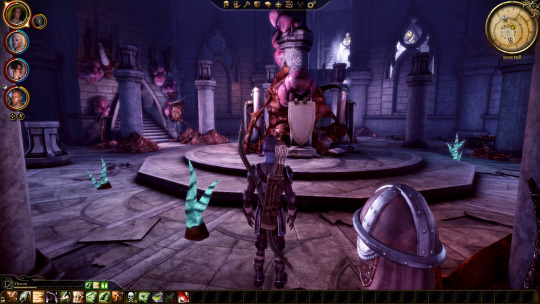
So, we know from DAO that lyrium grows in the fade. It even manifests in reality in the circle tower quest, on the third level no less, because the veil is thin (well close to non existent there).
Knowing what we know now, this seems to be some pretty dark foreshadowing for DA4.

In DAI, we encounter a lot of red lyrium in the fade. I know many people have suggested the red lyrium is a manifestation, but I disagree. I think it’s real and it is growing far worse in the fade unchecked, possibly because the corruption dates back to a time when the elven empire was dependent on lyrium to sustain itself.
Is it not strange that most of the red lyrium we find in the physical world has been intentionally grown and reproduced (eg. Emprise Du Lion and the Storm Coast) or where there has been death (thus affecting the veil)?
The only place we see an abundance of red lyrium without much human intervention is at the Temple of Sacred Ashes.This is significant because this is where the breach was first opened.
When you first get to the temple in DAI, Varric is confused as to how the red lyrium got there:
“You know that stuff is red lyrium, Seeker"
“I see it, Varric”
“But what’s it doing here?”
“Magic could have drawn on lyrium beneath the temple, corrupting it..”
The temple is on a mountain, which could indicate a titan and abundance of normal lyrium, so Solas may still be correct (also note he suggests it was magic from the anchor that caused the corruption!!!) However, I think the main reason why the temple is so overrun with red lyrium is because the corruption came through the breach.

The temple features some pretty massive lyrium veins close in size and shape to the ones from the fade. It’s also interesting to note the rocks at the temple glow green like the fade as well (similar to the crossroads too, incidentally) - right alongside these shards of red lyrium.
I think the simple fact that lyrium can manifest from the fade in reality is significant, because if the veil was destroyed by Solas in DA4 (looking very likely at this point), it means red lyrium from the fade could easily manifest into the physical world.
This could explain why we see an abundance of red corruption above ground in the teaser images- because red lyrium has manifested from the fade into the physical world (not the other way round).
The veil is seemingly destroyed (see the green in the sky), and the flesh sacs are eerily similar to the demon growths we saw in DAO’s circle tower quest, indicating demons and abominations to come.
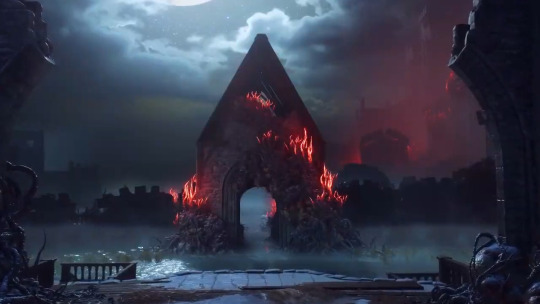
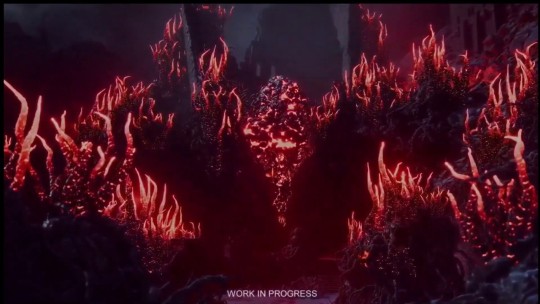
This is why I’m hesitant to believe that pulsating mass we saw in that DA4 teaser is in fact a titan heart. Not only is the corruption and mass above ground inside a castle, the flesh sacs all lead to this central, pulsating mass that looks corrupted, scorched, and molten (like it’s been through a fire?). Those red tendrils in the teaser may look like deep mushrooms, but they also look like the lyrium veins we see in DAO.
Considering the fact demons and abominations arose from similar fleshy growths in DAO, the fact so much red corruption is found in the fade, and the fact these growths lead to the “heart”, it seems to me like the pulsing mass is actually the precursor to a super demon or corrupted being about to emerge into the physical world.
The mass has a likeness to the red lyrium idol as well, which we know is integral to Solas’ plans (based off TN). Could this be what Solas has been planning all along or is this something else, maybe a mage’s ritual gone wrong?
It’s worrying enough that Solas is dabbling with the idol in itself, but he’s also clearly got limited options with his orb destroyed (he is a means to an ends kinda person after all).
I don’t believe the idol even forms a part of his veil destruction plans, because from TN we see that he has already started the ritual and it will take several years to complete. Rather, I think the idol has more to do with his plans for the imprisoned gods, of which we are still completely in the dark as to what he intends.
I wrote in a previous post about some potential symbolism with Mythal and demons from DAO in the circle tower. Knowing Bioware planned a whole lotta stuff in DAO for future games, and the fact that Mythal herself says she *and* the world were betrayed, what are the chances she has a personal stake in the blight itself?
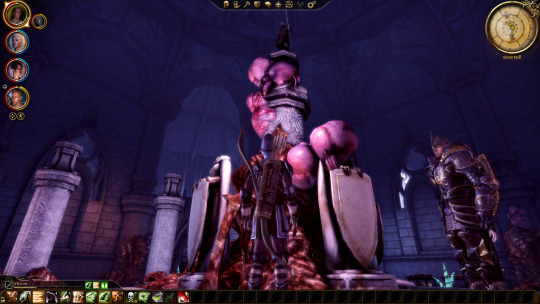
Often in stories, especially fantasy (think LOTR which DA is heavily inspired by), the hero needs to defeat evil with something that is in direct opposition to it- something to cleanse and purify/nullify. What if in this case the scenario was reversed?
We already know Dagna was able to nullify Samson’s red lyrium armour using red lyrium fashioned into a rune.
What if Solas intends to harness this very same corruption, something he clearly abhors, in an attempt to stop the blight / deal with the false gods for good, thereby losing himself in the process?
The imagery of him in the mural and even his tarot cards show him with red eyes...which is foreboding in itself.
I just have so many questions.
If red lyrium is growing out of control in the fade, how long has it been spreading and what triggered it’s growth in the first place? Keep in mind no one even noticed this variant of lyrium for thousands of years in the physical world, up until Hawke and co. found the idol. Then after the breach, pockets of red lyrium began appearing everywhere.
Is this why Solas has finally decided to act after observing world events for so long- because the idol is out in the wild? Or is it that his home, the fade which he loves so much, is increasingly being overrun by red lyrium and will soon be entirely blighted if he doesn’t take action?
The circular logic is what gets me about Solas’ plans - they’re clearly genocidal, but he also says in TN he is “saving the world”. If he hadn’t given his orb to Corypheus, would there still be red lyrium everywhere in Thedas? Or does his personal responsibility go back to ancient elvhenan, when he personally helped control a lyrium mine which was eventually collapsed due to the “evanuris’ greed”?
Is this why he feels like he must do what he “must” - because he is in part responsible for the blight? Or because he has the best chance of stopping it- before the world falls to it?
114 notes
·
View notes
Note
Hey, it's been a stressy week thus far and I'm trying to check in with people. I hope you're doing well! To talk about lighter stuff, do you have any thoughts on DA4 Solas?
I am doing as well as can be expected, and thank you so much for asking. It means a lot. I’ll admit I’ve hit the wall of fuckit, and sparking any joy right now is a challenge. I’m managing to do it, but the joy is small and fragile.
That being said, I do have thoughts on DA4 Solas. Did you want an in-depth analysis and essay? Cuz...uh...
I don’t think he’ll be the antagonist. Granted, it’s too early to tell since we don’t have any definitive information on what the plot is going to be, nor the worldstate. Will the Veil be gone? Will the main conflict be picking up the pieces after he’s done his thing or will we still be in a position to influence him? How much of Tevinter Nights will affect the story? How much are we going to know going in? Yes, Dread Wolf, your suspicions are correct, I have questions. Honestly, I think it’s more likely that he’ll play a role similar to Morrigan in DA:I, someone recruited or found that will either help or hinder from the background.
Digging a little deeper into Lamb’s Headcannon Glitterbomb, is he even Solas anymore? Or is he just the vehicle by which Mythal is exacting her vengeance on the world? Because that’s an option too. If I was writing a storyline that included such a premise, that’s where I’d put the Inquisitor. They are the only one coming out of a post-Inquisition worldstate that knew him before he absorbed Mythal’s power. They would be the one most likely to put together the clues and realize that the key to stopping him (if that’s a thing that could happen) is freeing him from her clutches. And yeah, that might entail killing him. I hope it doesn’t. I think that’s also where one’s relationship with him would come into play. A high approval Inky would have a much better shot at saving him from literally himself than a low approval one. Frankly, I hesitate to even think about what the default setting on that one would be. I’m sure I’d be disappointed (although maybe not, Patrick Weekes seems to have a decent understanding and narrative appreciation of Solavellan Hell).
I highly doubt we’ll be offered the chance to join him, which is a bit unfortunate, but would probably make the gameplay too complicated to develop. I mean, I get that games like this are a version of choose your own adventure and role playing, but having an option like that would potentially make too much divergence in the plot. BW, for all its ability to do the morally gray pretty well, is still black and white when it comes to decisions and having them affect the outcome. Plus this franchise seems to consistently underestimate the demographic that genuinely wants to help the oppressed. Like, you pay in heart’s blood to make decisions that actually would ease people’s suffering. For instance, support the mages in DA:I? Get flung through time and watch all your companions die for you. Live with the knowledge that your Inky’s arc exactly matches his in terms of rewriting the past to ‘fix’ it. You even get to say the same thing, that this world isn’t real.
And none of this even touches on what kind of power does he, himself, have? Roamer of the Beyond, Bringer of Nightmares, the Great Wolf. Those aren’t cutesy nicknames. That is one highly overpowered Egg. He claims no divinity, but that doesn’t mean he isn’t the walking definition of a god. He can kill through dreams, he can turn people to stone with a thought, he sundered the world from itself. I don’t think stopping him by force is really going to be an option. And if it is, I will be supremely disappointed in the writing team. I know BW is guilty of retconning previous information and events, but dayum. If we’re suddenly able to just...wipe him out, that makes everything seen in Trespasser and everything included in TN useless and pointless.
Hmm, I might have gotten carried away here...sorry. Thanks for the ask, it was nicely diverting from real life for a while.
9 notes
·
View notes
Text
Well Shit: The Elvhen Ritual (Part 4 of 4)
We have examined why the Well of Sorrows was so important to the ancient elvhen Sentinels, the origins of the Vir’abelasan, and whether Dirthamen’s Temple once contained a Well as well.
If our theory that the Well of Sorrows is more than a plot device for Inquisition, and that it and many other important story elements for the rest of the Dragon Age series were previewed in earlier games, then it stands to reason there should be something like the Well of Sorrows in Origins or DA2. And it is there.
In fact, most of our Wardens drank from the Well, which could lead to a “Well, shit!” moment for the Warden if they are still alive (and make an [unlikely] appearance) in DA4.
The ruins in the Brecilian Forest are extremely interesting. There are so many important details in them that they could be a series of posts unto themselves. They, and the ruins in the Dalish Origin, point to elves and humans living together side by side after the Veil was created for hundreds of years before Tevinter shows up.
The Wiki says that the Brecilian Forest ruins are probably Tevinter in origin, but honestly that seems highly unlikely given what we find in them and the history we learn from the elf trapped in the spirit crystal. There are signs that indicate these ruins once used eluvians as doors in some places and the presence of what is almost certainly a Well of Sorrows.
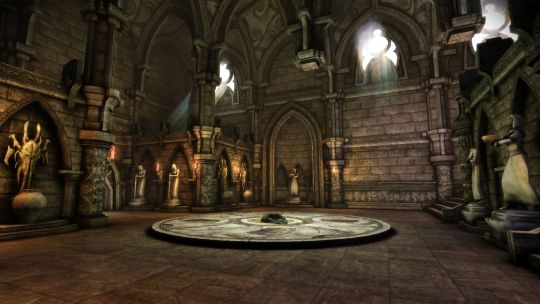
Before we get into the details of who created this well, let's first examine if it is actually a Vir’abelasan. There are many indications that the “fountain” in the depths of the temple was used to prepare the honored elven elders for uthenera, just like the Well of Sorrows. When you pick up the tablet that starts the Elven Ritual quest you get a message that says:
“Most of the carvings are faded. What little you can make out involves a scene where the honored dead is laid to rest inside a grand chamber.
There seems to be some kind of process involving the altar before the body can be laid to rest, but most of those runes are illegible.”
The text could be interpreted as a funerary ceremony, but when you read the codex entry for the tablet, it details a process that seems very similar to the ritual that occurred when servants of Mythal placed their memories and knowledge in the Vir’abelasan before entering uthenera.
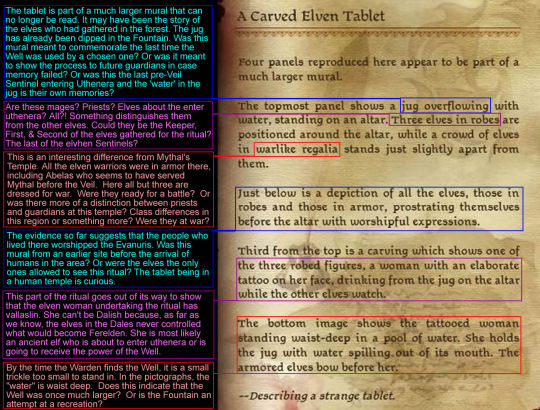
A Warden who didn’t know anything about the Vir’abelasan would, of course, have interpreted these scenes as some sort of cleansing ritual, but post Inquisition the image of an elf with vallaslin standing in a pool pouring something into the ‘water’ while being revered by other elves takes on another meaning.
There are differences, of course. There doesn’t seem to be an altar near the Well in Mythal’s Temple, and the “Well” is very small. The Warden doesn’t seem to gain any great insights or whispers that help them understand the ancient mysteries. Problematic, but not necessarily a sign that it was not a Well. So what else do we have?
There are some other indications that there is a “will” or force influencing the actions of people who come in contact with the Brecilian Well/Fountain. In the text describing the Warden’s thoughts and actions while interacting with the Fountain and altar are very interesting:
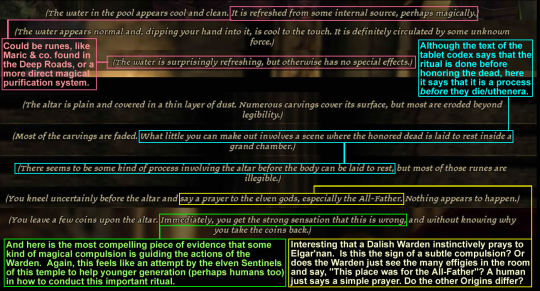
Some force or intelligence subtly prompts the warden away from ‘common’ mistakes, like leaving an offering. It is interesting that small mistakes such as the offering are acceptable, but once the clay jug becomes involved shades punish those who do the ritual wrong. It is interesting that shades attack the warden if they drink all of the water from the jug, leaving nothing to pour back into the fountain. These shades can be defeated with relative ease, but it is a stern reminder to do the ritual correctly.
The warden can still finish the ritual correctly even after the shades attack them, which again suggests that this ritual was supposed to be idiot proof. It was more important to the creators of the ritual that it be finished than it was for it to be done correctly the first time. This suggests that they expected the people performing the ritual to not know the proper forms of the ritual and that they might need a second chance. This is suggestive and we will circle back to this idea in just a moment.
This may not be conclusive proof that this Fountain is a Well of Sorrows, but the totality of the evidence is certainly pointing that way. The images inscribed on the tablet alone make it more than likely that the elves who once lived in the ruins knew about the ritual performed in Mythal’s Temple. Now we have a few other questions to answer: Is this an original Well of Sorrows? A remnant that was revived by later generations of elves? Or was it a recreation of a Well by elves who were not clear about exactly how to do the ritual?
Option 1: The Fountain is an original Well of Sorrows.
Given the number of differences that exist between the ritual we see in Inquisition and the images shown on the tablet it seems unlikely that the Brecilian Forest Well is an original. The elven mage who trapped his own spirit in a crystal just before the temple (and presumably it’s inhabitants) was destroyed, said that the ruins were built by humans, not elves. These two facts together make it very unlikely that the Well is one of the originals dedicated to preserving the Sentinel’s knowledge.
Option 2: The Fountain is a remnant of an earlier Well that was revived by later generations of elves and their human allies.
This is a distinct possibility. All of the history we have of elves and humans in the post-Veil ages suggests that they lived and interacted together in Ferelden. The elf in the spirit stone doesn’t seem to fear or resent humans, but rather describes both races living side by side.
This fits a pattern we see at other important sites across Ferelden. There is evidence at the Temple of Sacred Ashes, the Silverite Mines and Drake’s Fall in Awakening, and Ostagar that humans built important ritual centers and fortresses on the foundations of ruins from Elvhen Empire. (Full disclosure here, the Ostagar evidence is a bit shaky in that the basement area of the Tower is an exact match for the ruins in the Dalish origin. The fact that the designers decided to use that same human/elven motif at Ostagar, however, is suggestive.)
Although Tevinter may have put a decorative spin on these and other locations, there is evidence that these ceremonial centers existed before Tevinter invaded Ferelden.
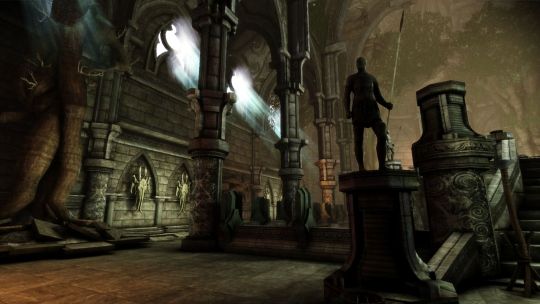
Tevinter had already taken credit (perhaps rightly so, perhaps not) for destroying Arlathan so it is unlikely that any local elven tribes would see them as a potential ally. It is far more likely that the elves found common ground with some of the Alamarri tribes or their descendants, the Avvar, the Clayne, and the Chasind and worked with them to rebuild important ceremonial sites that were laid waste during the wars fought among the elves after the Evanuris were sealed away or that may have been destroyed by the creation of the Veil. This would explain why so many sites have traces of Alamarri influence, but also seem to have possessed eluvians. (I will probably have to write more about this in another post. This one is already creeping up in the word count.)
The fact, however, that the Fountain behaves so differently than the Well of Sorrows, and does not seem to affect the Warden like the Well controls Morrigan or the Inquisitor, points to a third possibility.
Option 3: The elves recreated a Well as best they could, but were not clear about exactly how to make the ritual work as it did in ancient times.
There is also evidence that, while it was based on the Well, the Fountain was actually a not an original item, but an attempt to reclaim some elven glory. Evidence for this possibility can be seen in the text inscribed on the ritual tablet and the “results” of drinking from the Fountain.
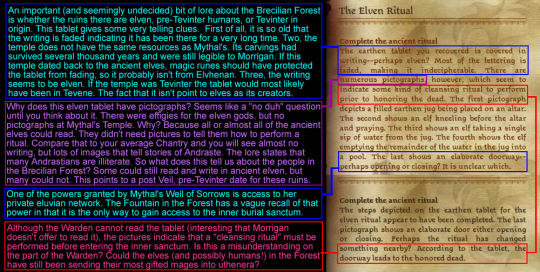
The quest text says that the warden uses a series of pictographs, rather than the elven writing, to figure out how to open the uthenera chamber. This suggests the text dates from a later date than Mythal’s temple because the who worshipped there did not need pictographs. They could read elven. How long does it take to forget your own written language?
In the real world, the Maya seem to have lost their ability to read and write in their language in about a century. The combination of the Spanish invasion of their homeland, the wars that followed, along with the diseases brought from Europe were a devastating combination. The Spanish burning Mayan codices and (if I remember correctly) wiping out the Mayan priests along with their religion didn’t help the situation.
This seems roughly analogous with what we see in the elvhen empire. The wars between the elves along with the quickening could have taken a toll on the ancient elves ability to read and write in elven. It probably was a slower loss, but it might explain why the tablet is half in script and half in pictographs.
Of course, the pictographs were for the benefit of the ignorant humans moving into the region, who probably couldn’t read or write elven. There doesn’t seem to be, however, any humans pictured on the tablet so it doesn’t seem likely that they were the primary audience for the tablet.
One final thought on this point: Is the Warden under a compulsion or geas to one of the Evanuris if they drank from the well? And, honestly, there is no way to say yes or no at this point. There is no sign that the Warden is hearing voices like Morrigan or the Inquisitor does, but there does seem to be some mild compulsions associated with the ritual leading up to the Fountain. We don’t know whether the Fountain would have given the warden access to the eluvians that were probably still in that temple when the Fountain last was fully functional. Drinking from the Fountain does give the Warden access to the inner burial chamber, which is reminiscent of Mythal’s Well.
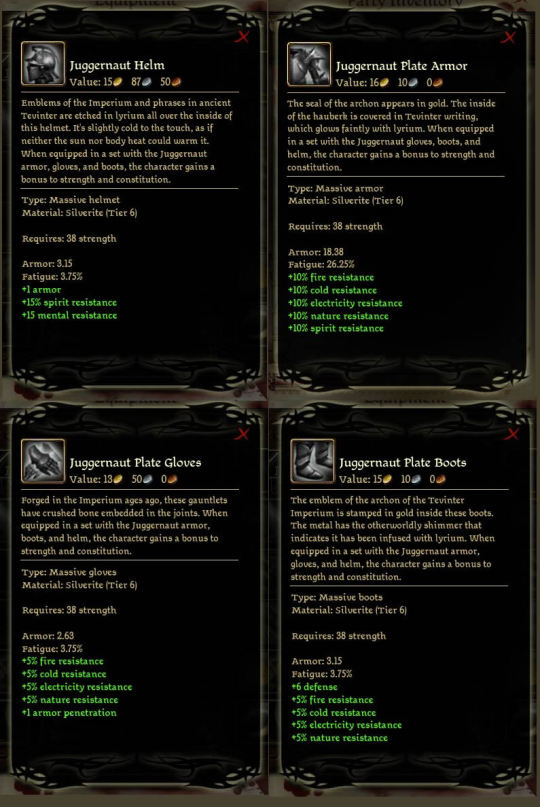
Given the fact that the elves, the Clayne, and Tevinter fought for control of the Brecilian Forest and the last Revenant and piece of the Juggernaut armor associated with the mage’s treasure quest is found in the burial chamber...it is possible the Fountain had already lost its knowledge and there were not enough elves who knew about the ritual to carry on with it after Tevinter was driven from the forest.
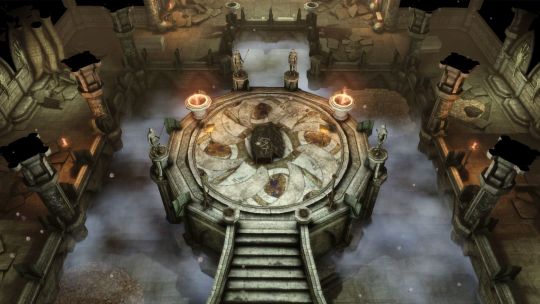
Tevinter had to fight the elves and the Clayne “inch by inch...using terrible magic” to take over the Brecilian Forest. This is reminiscent of the story the elf in the spirit stone tells the Warden, yet we have no proof of whether the temple had already been despoiled in earlier conflicts or if Magister Harach or another Tevinter took the knowledge of the Well.
I also wonder if the Fountain was merely the gateway to the real Well on the inside of the chamber. The tablet said that the elf with vallaslin stood in ‘water’ that was waste deep, and it would be pretty difficult to do that in the little puddle in the outer chamber. Perhaps the real Well was actually the large, misty pool in the inner chamber. All that seems certain is that there was not enough knowledge left in the Fountain to be noticeable to the Warden.
Geas-y Wardens?
So is the Warden under a geas? Even without the knowledge of the Fountain, there may be enough of a compulsion on the Well that the Warden could be in trouble if the Evanuris to whom the Fountain was dedicated is released from the Fade. We have several possibilities as to who that might be. Elgar’nan is all over the room and Andruil along with Sylaise can be seen in the alcoves.
But there is one interesting and almost hidden figure in the room worth mentioning. Look closely at the altar where the water from the Fountain is empowered (or whatever happens to it). There is a symbol for another Evanuris on it.
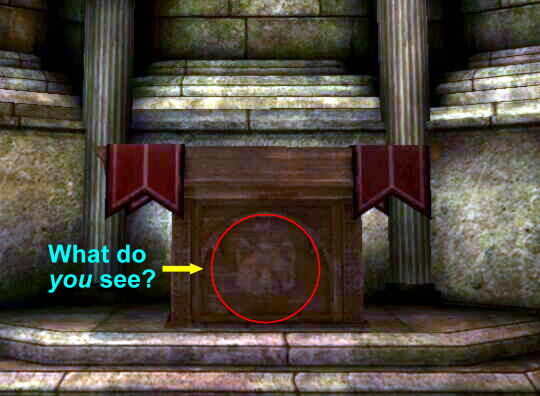
Looks like a bear to me, a symbol for Dirthamen. Could lead to interesting things....
-MM
Think you missed part of the “Well Shit” series? Here are our previous posts:
Part 1: Searching for the Secrets of the Elvhen Gods
Part 2: Origins of the Vir'abelasan
Part 3: Dirth of Knowledge
Part 4: The Elvhen Ritual.
#dragon age#dragon age origins#brecilian forest#Brecilian forest ruins#vir'abelasan#Well of Sorrows#mythal#dirthamen#Elgar'nan#andruil#sylaise#evanuris#elvhenan#dragon age ancient humans#uthenera#dragon age meta#dragon age theories#morta's musings#long post#thanks for reading#life kicked me in the head three weeks ago#took a lot longer than I would have liked to finish this post
137 notes
·
View notes
Text

@felandaristhorns asked: This might be more meta than headcanon (and you may have already said something about it), but I'd love your thoughts on the parallels between Solas killing the mages who tortured and corrupted Wisdom versus Cole sparing and forgiving (with Solas's guidance and encouragement) the templar who imprisoned and forgot the real Cole.
Hm! I think I’ve spoken about it before, although potentially only in private? I remember talking to Joly once about how it, but it was mostly about how I think comparing the two like it’s apples to apples is weird, especially because the post in particular was one sentence and equivocated what I think are two different crimes. I’m going to do my best to put them into context about the ways I think they’re hard to compare before I compare them just to make myself feel better.
Oh, and before I start, these are just my interpretations of the quests and mostly applicable to how I write these characters here and on my multimuse in Cole’s case.
The Templar who killed the human Cole did so out of negligence and cruelty, Cole was (in the fucked up system of Thedas) the Templar’s responsibility and he failed him. The mages who kill Wisdom do so out of ignorance, mostly, having been educated by that same system which taught them that Wisdom wasn’t a person and thus fine to enslave and pervert. These are both bad things, and some action deserves to be taken in either case,* but they aren’t the same crimes.
Not only this, but they serve different narrative purposes. I see the mages as a foils Solas and the situation he’s in, they did something drastic to protect themselves and a lot of them ended up dying as a result. Also, they fail to recognise the personhood in Wisdom just as Solas fails to recognise the personhood in the world he woke up to. Let them die or stop him, his path isn’t divergent like Cole’s, he’s grateful for your help even if he disapproves of you letting them go. Meanwhile, the Templar in Cole’s is more a springboard for how he’s going to develop from here on out. He represents Cole’s investment in the identity he forged for himself, but there aren’t many traits he and the Templar share as there are with Solas and the mages.
So, we have two different situations featuring characters who serve different narrative functions for our companions. Now that I’ve made it clear that they’re different I can try to talk about the similarities.
The first similarity that comes to mind is actually between Solas and Cole if you take the alternate route, where Cole doesn’t forgive. He keeps the anger, lets it change him, he’s more relatable but a little less happy. If you let the mages go, Solas doesn’t forgive them, he keeps that fury. You can feel that anger going into Tevinter Nights, where his fury about how spirits are being treated in Thedas characterises his appearances. Solas has had a body for a while, so it’s not like this anger has changed his nature, more that I think he knows better than he lets on that he gets the pain Cole is going through by letting this stick to him. Encouraging Cole to forgive is a way to keep Cole from going through what he’s gone through. It’s also I think a result of the Veil and its nature, were the world different I think Solas would have preferred a middle ground, as was possible before the creation of the Veil.
I also think there’s something to be said about vengeance not being a healthy path for them. As I said, Solas doesn’t have a divergent path and reacts with gratitude regardless of if you let him go through with it, but I do think that letting him kill the mages imparts a bad lesson for him. Especially if you buy into my “the mages are Solas” interpretation. For the moment it has no repercussions on Solas’ story, but it still may, and personally I think the Inquisitor who showed mercy to mages who did something terrible to protect people they loved would have a better bearing on Solas’ future (assuming you want him in a better place at the end of DA4) than letting them die. For Cole, we aren’t allowed to pursue that path because his story is divergent, and it would be more dialogue to write, more lines to read, more scenes to code, etc. There are hints that it was planned, but likely had to be cut from the development process for the reasons listed above. I do think that if such an option was pursued, it would’ve been bad for Cole.
I guess the final and most compelling parallel I can think of is how Solas and Cole deal with their own grief versus others’. Cole shows compassion to Solas, who has the death of an empire (or rather, its people) sitting on his shoulders, shows compassion to Blackwall, who had ordered the deaths of civilians and allowed the deaths of children. Wanting someone who committed a crime dead isn’t out of the unusual for Cole (he does approve of execution an equal number of times as Solas does. Fun fact.), but oftentimes when dealing with the pain of people whom many would consider monstrous Cole tries to help them move on from their trauma. Not so for the Templar, who may not have lived if Cole had acted alone that day.
Solas is a fair bit colder than Cole, he’s had to make hard decisions in a way similar to the Inquisitor, and people have died as a result. Yet when dealing with Blackwall he ultimately chooses to accept that he’s changed and, if Blackwall is romanced, Solas is glad he’s found some peace with someone who can love the true him. He’s the only member of the initial party who tries to reason with the mage supremacists that broke from the rebellion, and he, too, finds compassion for people who are considered monstrous-- sometimes literally. His compassion is harder than Cole’s, but undeniably there.
Yet when faced with their own trauma and grief, they both turn to rage. Solas is self-admittedly hotheaded and I think well-aware that it’s not good to indulge that side of himself, and while he doesn’t have enough in him to control himself when it comes to the loss of one of his oldest friends (at least not without outside help), he has enough of a grip during Cole’s quest to advocate a softer resolution for his friend. I wish Cole could’ve played a role in Solas’ personal quest as Solas did for Cole to neatly tie up this package, but alas. I could see Cole stopping Solas, I imagine at that point more of him was bleeding through and he was a good deal louder than usual from Cole’s perspective, but that’s getting into speculation.
In short, I think they’re difficult quests to draw parallels between because they serve very different purposes for Solas and Cole, and the crimes featured in them are different morally. Some similarities can be found in questions the quests raise about vengeance and the fact that Solas may be advocating from the perspective of someone who had to go through what Cole is about to go through. Ultimately though I think the most compelling parallel is the way these characters express their grief and how they help their friends’ handle their grief.
* By this I mean I think the mages deserve education and protection, their crime was a result of desperation and I think they deserve compassion. The Templar I think deserved prison or some kind of judgment, although ultimately I choose forgive because I prefer it for Cole’s development and he comes before everything else.
#all new‚ faded for her ( quests )#a pain you can't heal ( cole )#( solas meta )#[ cole's pq always makes me think of the southern raiders episode in atla which is one of my fave episodes#coincidentally cole's pq is my fave personal quest in the series ]#tevinter nights spoilers#[ sort of! only briefly referenced ]#( asks )
8 notes
·
View notes